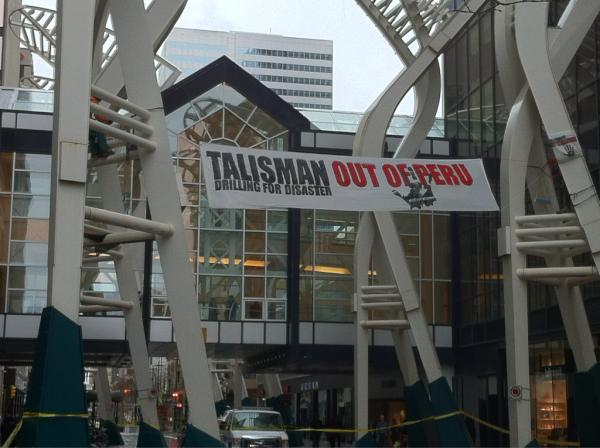
by Deep Green Resistance News Service | Sep 14, 2012 | Colonialism & Conquest, Indigenous Autonomy, Mining & Drilling
By Amazon Watch
Today Talisman Energy (TLM) announced its decision to cease oil exploration activities in the Peruvian Amazon and to exit the country upon completion of ongoing commercial transactions.
“We have fought long and hard against Talisman’s drilling in our territory because of the negative environmental and social impacts we have seen from oil drilling around the world,” said Peas Peas Ayui, President of the National Achuar Federation of Peru (FENAP). “Now that Talisman is leaving we can focus on achieving our own vision for development and leave a healthy territory for future generations.”
Talisman is the fifth oil company to withdraw from controversial Block 64, located in the heart of indigenous Achuar territory in a remote and bio diverse region of the Amazon rainforest. Talisman has been exploring in Peru since 2004 and has come under increased pressure by human rights groups and shareholders for operating without Achuar consent.
“Talisman has had to face up to what the Achuar told them when they first invested in Block 64: The company cannot drill without the consent of the Achuar people,” said Gregor MacLennan, Peru Program Coordinator at Amazon Watch. “Talisman’s exit sends a clear message to the oil industry: Trampling indigenous rights in the rush to exploit marginal oil reserves in the Amazon rainforest is not an option.”
Despite Talisman’s claim of attaining local support from communities and signing good neighbor agreements with 66 communities downriver from their operations, the company never had the consent of the majority of communities living within Block 64. Talisman first invested in Peru one year after leaving Sudan and became sole operator in 2007, shortly after John Manzoni’s appointment as CEO. Manzoni was replaced by ex-TransCanada CEO Hans Kvisle on Monday this week.
“We are the owners and the original people of this land,” said Peas Ayui. “No outside person or company may enter our territory by force, without consultation and without asking us. We have been fighting against oil development on our land for 17 years and we maintain the same vision to protect our territory and resources for future generations. Let this be a clear message to all oil, mining and logging companies: we will never offer up our natural wealth so that they can extract our resources and contaminate our land.”
Block 64 is just one of several new efforts to extract oil from the headwaters of the Amazon in Northern Peru and Southern Ecuador, among the most bio diverse places on earth. Anglo-French company Perenco was recently awarded a production license to operate in Block 67 in Peru despite a legal case against them for drilling in isolated peoples’ territory. ConocoPhilliips has faced mass protests in Iquitos, Peru over plans to drill wells in a protected area in the Nanay river basin east of Block 64. In Ecuador, the government plans to auction new oil blocks on the Peruvian border despite strong indigenous opposition. The Kichwa community of Sarayaku recently won a case in the Inter-American Court of Human Rights against the Ecuadorian government for signing an oil contract without their consent or consultation.
From Amazon Watch: http://amazonwatch.org/news/2012/0913-talisman-energy-withdraws-from-peruvian-amazon
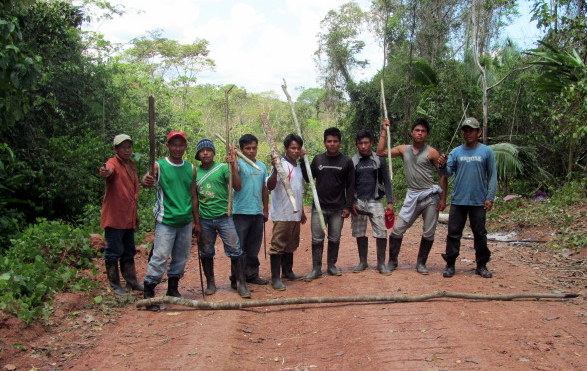
by Deep Green Resistance News Service | Sep 10, 2012 | Indigenous Autonomy, Mining & Drilling, Obstruction & Occupation, Toxification
By Ronald Suarez, Network of Peruvian Indigenous Communicators, Ucayali
Over 400 villagers in the Native Community of Canan de Cachiaco in the Ucayali region of the Peruvian Amazon have taken control of nine oil wells, belonging to oil company, Maple Gas, in oil lot 31B.
Community members took over the oil wells on September 2nd, and continue to hold them as a result of 37 years of oil contamination in their territory by the company.
The community leader, Basilio Rodriguez Venancio, said the action was made necessary because the company did not consider the environmental impact assessment carried out by an independent consultant.
The community is demanding that the company pay them compensation for the use of their lands and for the environmental damage they have suffered for 37 years. Such damage includes the contamination of their rivers, their only source of drinking water, and the contamination of their soils due to the company’s use of chemicals and heavy minerals, which the population says has significantly affected the productivity of their land.
Several community members testified that they have become sick due to the company’s negligence and contamination of their drinking water. There have been several instances in the past years of cancer and ¨unknown deaths¨ that the community attributes to company abuses.
The community awaits the arrival of state representatives from the Ministry of Energy and Mines and Ministry of Environment, scheduled for Thursday, September 13th, to resolve this conflict.
Meanwhile the villagers are still stationed in the camp until authorities settle their claims.
From Alianza Arkana
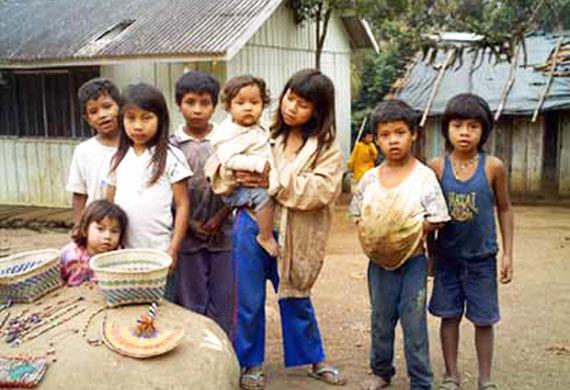
by Deep Green Resistance News Service | Sep 4, 2012 | Colonialism & Conquest, Indigenous Autonomy
By Inter-Press Service
The land conflict between the Guaraní-Kaiowá indigenous people and large landowners in the southwestern Brazilian state of Mato Grosso do Sul is a powder keg ready to explode, say observers.
Nísio Gomes, Jenivaldo Vera, Rolindo Vera, Teodoro Ricardi, Ortiz and Xurete Lopes are just a few of the names on a long list of people murdered in this state in recent years, according to the Indigenous Missionary Council (CIMI).
The statistics gathered by the Council, founded in 1972 by the Brazilian National Bishops’ Conference, reveal that 279 indigenous people have been killed since 2003 in land disputes with landowners and ranchers.
The most recent case is that of Eduardo Pires, who disappeared on Aug. 10 when armed men attacked a group of Kaiowá people in the Arroio Korá indigenous reserve, located in the municipality of Paranhos in the south of the state, near the border with Paraguay.
Arroio Korá, an area of roughly 7,000 hectares, was officially recognized as indigenous land on Dec. 21, 2009 by then president Luiz Inácio Lula da Silva. But one week later, a Federal Supreme Court ruling on an appeal filed by a landowner exempted a 184-hectare section of the land from this status.
“Even with this partial embargo, the government did not foresee that the rest would be effectively turned over to the Guaraní-Kaiowá,” said Flávio Machado, the CIMI regional coordinator in Mato Grosso do Sul. “The community, which is made up of around 600 members, currently occupies around 700 hectares. When they decided to retake control over the rest of the land, they met with a violent response,” he told Tierramérica*.
According to Eliseu, a Kaiowá leader who was present when the attack took place, on the morning of Aug. 10 some 400 members of the community set up a camp on a section of the officially recognised reserve land where a ranch is located.
A short time later, a number of armed men arrived. “I heard the gunshots and took off running. We are a people with a culture of peace, we have no weapons, but we are not going to give up fighting for our land. If we are going to die, we would rather die on our own land,” he told Tierramérica.
No one has seen Eduardo Pires since the attack. “I believe he is dead,” said Eliseu.
The Federal Police of Mato Grosso do Sul are in charge of the case. “The indigenous people say that one of them is missing. We are investigating, but we have nothing concrete. We have to be impartial,” Federal Police Superintendent Edgar Paulo Marcon commented to Tierramérica.
The following week, CIMI reports, the police removed a number of ranchers and their cattle from the area. Since then, the Kaiowá have been targeted by threats, the most explicit of which is a filmed declaration by Luis Carlos da Silva Vieira, known as Lenço Preto (“Black Kerchief”), posted on YouTube.
“We are going to organize and prepare for confrontation…They only want the land to be bothersome. We have weapons. If they want war, they’ll get war,” he states repeatedly.
In response, the Kaiowá community published a letter calling for urgent attention from the government. “Faced with a collective death threat, made publicly in the press by the landowners, we request an investigation and severe punishment of these promoters of the genocide/ethnocide of indigenous peoples.”
“Everyone knows that they have sophisticated and fearsome weapons, that they have money obtained at the expense of indigenous blood to buy more weapons and to hire gunmen… We do not have guns and, above all, we do not know how to use them,” the letter continues.
“We want to reiterate and highlight the fact that our fight for our ancestral lands is aimed solely at protecting human life and the fauna and flora of the planet Earth; it is not our intention to kill anyone.”
From Upside-Down World: http://upsidedownworld.org/main/brazil-archives-63/3844-brazil-landowners-declare-war-against-indigenous-guarani-kaiowa-in-mato-grosso-do-sul
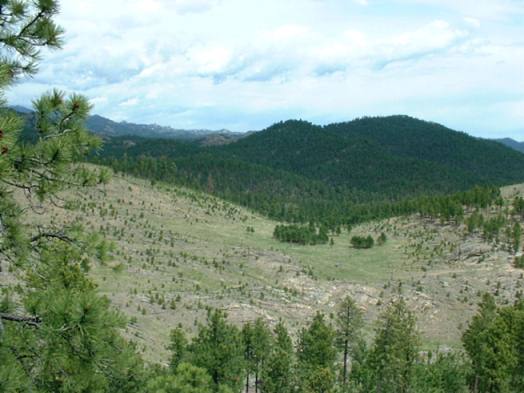
by Deep Green Resistance News Service | Sep 4, 2012 | Indigenous Autonomy
By Lakota People’s Law Project and Last Real Indians
Last Saturday, at a press conference in Eagle Butte, South Dakota, Lakota leaders of the movement to secure the Lakota pilgrimage site Pe’ Sla for the Sioux Nation announced that the tribes will purchase the 2000 acres of sacred land in the Black Hills. After several weeks of intense fundraising, the nine tribes raised enough to make a deal with the current owners of Pe’ Sla, Leonard and Margaret Reynolds—though details of the arrangement are still being negotiated. The fundraising effort on the part of the Sioux tribes was begun by Attorney Chase Iron Eyes, and the negotiations were carried out in part by Cheyenne River Tribal Councilwoman Robin Lebeau. Both leaders spoke on Saturday. Saturday’s action was organized by Last Real Indians and the Lakota People’s Law Project, two organizations operating in South Dakota that support the return of the Black Hills to the Sioux.
Saturday’s action was organized by Last Real Indians and the Lakota People’s Law Project, two organizations operating in South Dakota that support the return of the Black Hills to the Sioux. The action took place in front of an enormous banner by artist Shepard Fairey and photographer Aaron Huey which read “The Black Hills Are Not For Sale,” a reference to the U.S.’s current policy of ignoring the Treaty of Fort Laramie (1851). The treaty, unilaterally overturned by Congress in 1877, acknowledged Sioux ownership of the Black Hills. The United States has offered the tribes $105 million (plus interest) since 1979 as compensation for the seizure of the land, but the Sioux have refused it and maintain that the land belongs to them.
Shepard Fairey created the red and blue “Hope poster” for Obama’s 2008 presidential campaign, and Aaron Huey is the photographer who co-created last month’s National Geographic cover story about the Pine Ridge Reservation. The banner art was driven from California to South Dakota by the Lakota People’s Law Project, an organization which works to return Lakota children from state-run foster care to their families and tribes.
Speakers at Saturday’s press conference were Chase Iron Eyes, spokesperson for the Pe’ Sla movement; Robin Lebeau, tribal councilwoman from the Cheyenne River Sioux tribe; Madonna Thunder Hawk, activist and tribal liaison for the Lakota People’s Law Project; Phyllis Young, activist and tribal councilwoman for the Standing Rock Sioux tribe; and Joe Brings Plenty, former tribal council chairman for the Cheyenne River Sioux tribe.
Iron Eyes described the process by which his organization, Last Real Indians, conducted a fundraising effort to save Pe’ Sla, raising $300,000. This sum was combined with $1.3 million put forth by the Rosebud Sioux tribe, enough to seal the land deal. Mr. Iron Eyes, an attorney in his mid thirties, discussed the teachings concerning the Black Hills that he received from his elders a a youth: “Its back, we’re talking about the Black Hills again, and it’s the right time for it to happen.” Councilwoman Lebeau, also under forty, described the complicated negotiations by which the tribes acquired the land. She implored the tribes to come together: “What I want to stress is unity… All I am asking for you [Sioux] to do is to take [the idea of Pe’ Sla] back to who whomever your spiritual leaders are—your treaty councils, your IRAs—and let’s come together.” Thunder Hawk talked of the importance of land possession to Sioux identity, saying “The land the priceless. The land is who we are. That’s why we still are who we are, because we have a land base…It doesn’t matter how much money the tribes have to put up for Pe’ Sla. We have to have it.” Councilwoman Young, who participated in the conference calls during which the land deal occurred, thanked both her fellow Sioux negotiators and the Reynolds family for obliging Sioux appeals. “As we continue to renew our belief systems and ceremonies, we urge our people to…continue as human beings to contribute and share our lifesystems with the world…so that Pe’ Sla becomes a universal symbol of peace everywhere.” Former tribal chairman Brings Plenty discussed the Sioux struggle for self-empowerment and the role that land plays in it. “This Pe’ Sla movement, it is a victory.”
The organizers of Saturday’s press conference are holding a rally in Rapid City this Wednesday, September 5, to celebrate the purchase of Pe’ Sla. It will be at the Memorial Park Band Shell at 5 PM.
From Intercontinental Cry: http://intercontinentalcry.org/lakota-announce-new-deal-with-landowners-for-the-return-of-pe-sla/
by Deep Green Resistance News Service | Aug 31, 2012 | Indigenous Autonomy, Mining & Drilling, Obstruction & Occupation
By Skwekwekwelt Solidarity
Concerned members of the Tahltan Nation have set up a road block on Highway #37, 80 km south of Dease Lake, BC at the Tatogga Lake Resort. The Red Chris Mine is within the territory of the Tahltan Nation who have occupied territory since time immemorial. The specific area where the Red Chris Mine is being constructed is home to many species of animals including Stone Sheep, Mountain Goat, Moose and Caribou. The Tahltans depend upon these animals for subsistence and believe that the mine will destroy the animal’s habitat and calving grounds that is sacred to the Tahltans.
The Tahltan Leadership has spoken out strongly against the mine and criticized the BC mine permitting process that is viewed as corrupt. The BC Liberal Government has given free rein to mining companies leaving the environment vulnerable to contamination and disruption. Tahltans have serious concerns with the design of the tailings ponds and the potential for leakage and wide scale environmental disasters that will result should tailings leak into the environment. At the Tahltan Central Council Annual General Assembly held in July 2012 a resolution was passed to develop a No Red Chris Campaign to oppose the Red Chris Mining Project.
Two Tahltan women Kukdookaa and Adanza’a will be at the blockade with other elders and concerned Tahltans handing out information and educating those travelling along Highway #37 about the critical issues facing the Tahltans and their homelands.
Adanza’a is a 73 year old great grandmother on the blockade to protect her homeland for her grandchildren so that they can enjoy what we have today without the destruction mining will bring. She said that, “Our ancestors fought and died for our homeland to protect our way of life for us and the least we can do is fight for our rights and the rights of generations to come.”
Kukdookaa is also a grandmother who believes in fighting for the rights of the Tahltan Nation and will go to any length to protect the Tahltan people, wildlife, fish, and the environment. “It is irresponsible of the BC Government to provide permits while serious issues remain unresolved with the people who occupy the area.” Wild game outfitters, resort owners and other business people also have concerns with the location of the road and the disruption to wildlife and the pristine wilderness.
From Intercontinental Cry: http://intercontinentalcry.org/tahltans-set-up-roadblock-to-oppose-red-chris-mine/
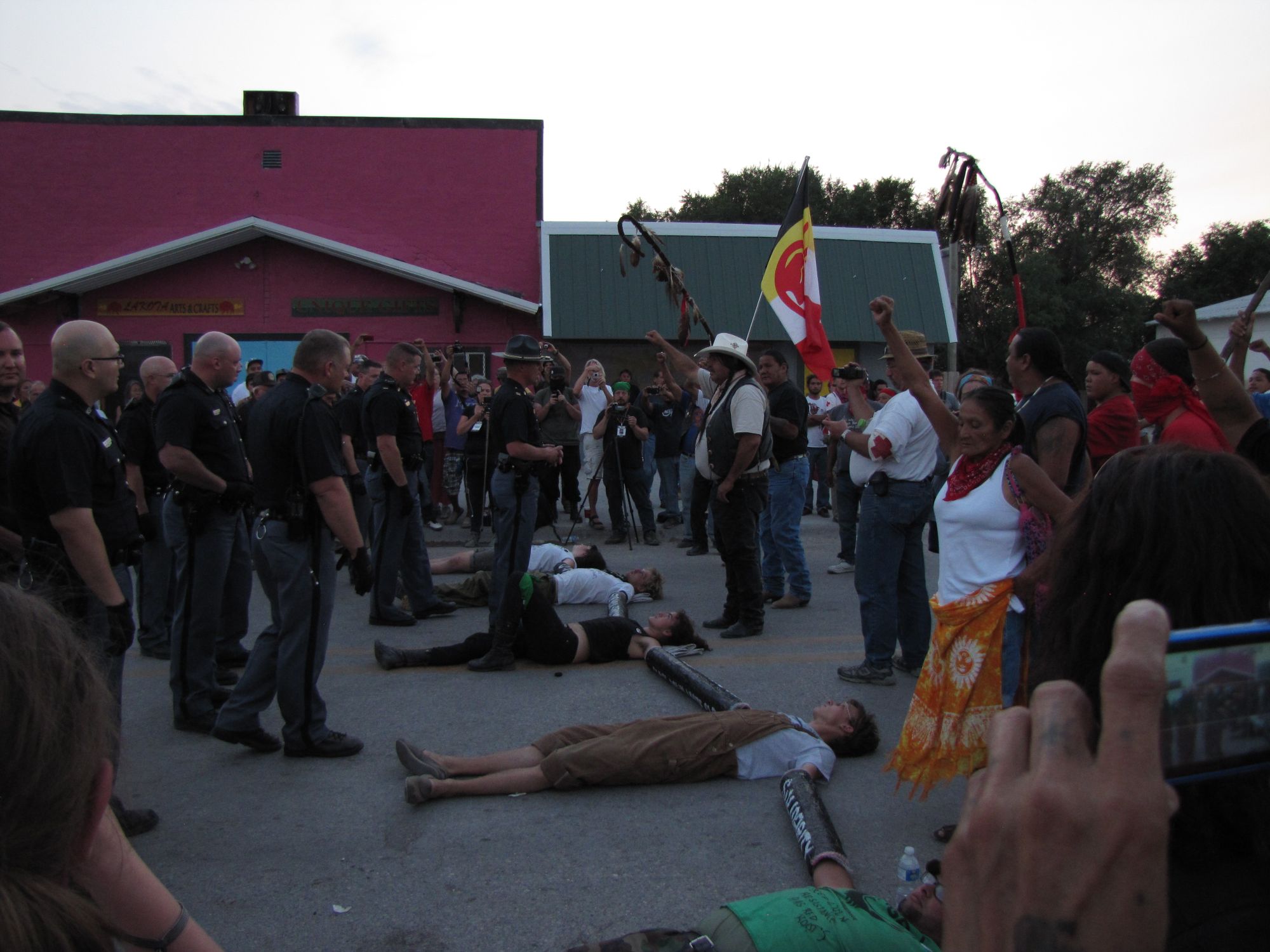
by Deep Green Resistance News Service | Aug 29, 2012 | Colonialism & Conquest, Indigenous Autonomy
Mujeres de la nación Oglala Lakota, junto con activistas de Resistencia Verde Radical, AIM Grassroots, Movimiento Nativo Juvenil, Un-Occupy Albuquerque, Occupy Lincoln, y el Centro de Paz y Justicia Rocky Mountain participaron en una marcha desde Billy Mills Hall en Pine Ridge hasta White Clay para protestar contra la industria depredadora de bebidas alcohólicas que está presente allí.
White Clay tiene, para una población de 14 personas, 4 tiendas de bebidas alcohólicas en el pueblo que venden 12,500 latas de cerveza cada día. Las tiendas han sido investigadas varias veces por haber vendido a vendedores ilegales, personas embriagadas, menores y tambien a cambio de favores sexuales.
“Durante más de 100 años las mujeres de la nación Oglala Lakota han hecho frente a un ataque a los mentes, a los cuerpos y a los espíritus de sus parientes”, dice Olowan Martinez, un organizador principal del evento y residente de Pine Ridge. “La Oglala han sido callados mediante la guerra química por parte de las corporaciones que explotan y se benefician del sufrimiento y de la miseria de nuestra gente. El tiempo ha llegado para terminar este sufrimiento por todos los medios necesarios.
Debra White Plume, una activista Lakota y residente de Pine Ridge habló durante el evento y proclamó, “Una indígena sobria es una indígena peligrosa. Tenemos que mandar un mensaje a Nebraska y a sus ciudadanos de que no vamos a tolerar los asuntos tal como están. Este es el Día de Paz de las Mujeres pero esta paz acabará pronto.”
Después de la marcha y de los discursos de los miembros de Resistencia Verde Radical, se hizo un bloqueo del camino hacia White Clay.
Media hora después de que el bloqueo comenzara, un agente policial bajó su ventanilla del coche y sin discriminación roció a la multitud con gas pimienta. Hasta 12 personas fueron rociados, incluyendo al hijo de 10 años de una mujer Lakota que ayudó a organizar la marcha. Tambien una anciana mujer Lakota, Helen Red Feather, denunció que su pierna fue golpeada por un coche policial. Médicos en la protesta trataron a las heridas producidas por el gas pimienta.
A las 7:39, los cinco activistas que participaron en el bloque fueron llevados en un remolque de caballos a la cárcel del distrito de Sheridan en Rushville. Después fueron liberados bajo su propia tutela.
Hoy en día falta mucho para que la justicia se cumpla, como en White Clay se sigue destruyendo a los Lakota Oglala y a la gente de Pine Ridge. La Oglala Lakota de la reservación Pine Ridge seguirán presos mientras las tiendas de bebidas alcohólicas en White Clay sigan funcionando.
Las consignas de “Tanto como dure!” fueron coreadas por la gente y por las personas que las apoyaban, de pie junto a ellas desde el comienzo de la protesta. La lucha continua.
Para más información sobre El Dia de Paz y La Marcha de Mujeres, y para fotos de la acción, visita a http://dgrnewsservice.org/2012/08/26/womens-day-of-peace-action-in-white-clay/
Quiere ayudar en la acción? http://deepgreenresistance.org/feature-help-support-indigenous-solidarity-in-whiteclay/
For the English version of this article, see http://dgrnewsservice.org/2012/08/26/womens-march-and-day-of-peace-turns-violent-protesters-arrested/





